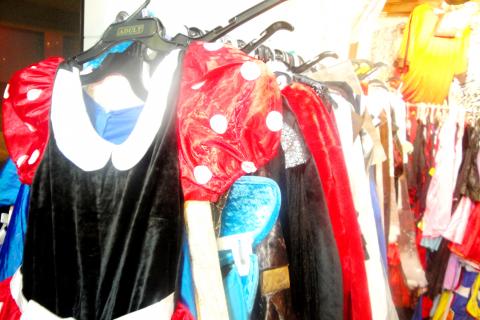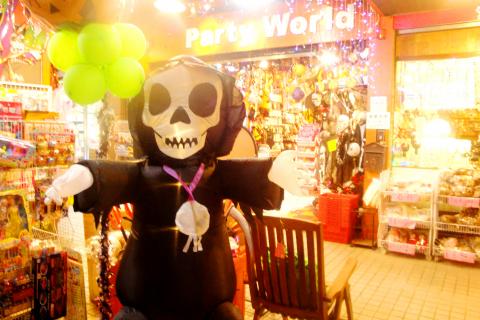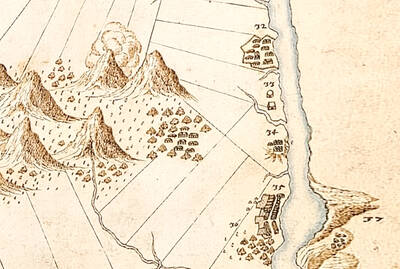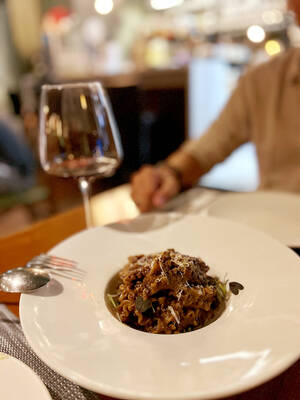Halloween is right around the corner and you still don’t know what to dress up as. You’ve been to the costume stores in Ximending (西門町) on Hanzhong Street (漢中街) and the good ones are already spoken for. It’s time to get creative on the aptly nicknamed Halloween Street, a block northwest of Taipei Main Station. This two-block area on Changan Rd (長安路) between Chongqing North Road (重慶北路) and Chengdu Road (成都路) boasts 14 stores that sell a variety of Halloween supplies ranging from disco wigs to swords filled with fake blood to superhero costumes for toddlers.
The Holiday House (節慶屋) at 95 Changan W Rd (台北市大同區長安西路95號), tel: (02) 2559-4897 is geared more towards women with the requisite flirtatious Little Red Riding Hood and risque female versions of Captain America costumes. Prices are between NT$499 and NT$599 for adult costumes and NT$100 less for children. Unfortunately, the Holiday House seemed like a Christmas store moonlighting as a Halloween shop.
A few steps down the road is Lucky House (吉祥屋) at 109 Changan W Rd (台北市大同區長安西路109號), tel: (02) 2550-0262. At first, the list prices on everything seemed to be a bit higher than the Holiday House, but soon the owner came over and started offering better deals. She turned out to be a spirited bargainer and a costume that contained a hat, wig and sailor’s dress went from being NT$970 to NT$750 with a few clicks on the buttons of her oversized calculator. Eventually, a price of NT$700 was settled on, but not before using the time-honored pretending-to-walk-away tactic of negotiation.

Photo: Marcus Aurelius
Technically not on Changan West Road but worth mentioning because it’s very visible from the intersection at Changan and Taiyuan is Party World Thematic Warehouse (派對世界) at 63 Taiyuan Rd (台北市太原路63號), tel: (02) 2559-9758. This two-level shop had the widest selection of all with kids’ costumes, fairy wings and tons of pirate paraphernalia. One of their specialties is all shapes and sizes of mylar balloons, which ranged in prices from NT$100 to NT$450 filled with helium. Overall, Party World would be the first place to shop to decorate for a Halloween party.
A few other tips for this area would be to do a walk through of all of the stores before making any purchases. Never pay the actual price on the tag for anything if it’s over a few hundred dollars. Add items together and ask for a group discount. If you want to dicker with the salespeople, they are more willing to cut down the prices, but do it out of earshot of other customers. Also, try to go at a time that is less busy. Every night from now until October 31 will be crowded with people looking for last-minute costume ideas. A stroll through in the early afternoon is recommended.
The Taipei Times will have complete Halloween coverage — from bars and clubs to dance halls — in next Friday’s Features section.

Photo: Marcus Aurelius

Last week gave us the droll little comedy of People’s Republic of China’s (PRC) consul general in Osaka posting a threat on X in response to Japanese Prime Minister Sanae Takaichi saying to the Diet that a Chinese attack on Taiwan may be an “existential threat” to Japan. That would allow Japanese Self Defence Forces to respond militarily. The PRC representative then said that if a “filthy neck sticks itself in uninvited, we will cut it off without a moment’s hesitation. Are you prepared for that?” This was widely, and probably deliberately, construed as a threat to behead Takaichi, though it

Nov. 17 to Nov. 23 When Kanori Ino surveyed Taipei’s Indigenous settlements in 1896, he found a culture that was fading. Although there was still a “clear line of distinction” between the Ketagalan people and the neighboring Han settlers that had been arriving over the previous 200 years, the former had largely adopted the customs and language of the latter. “Fortunately, some elders still remember their past customs and language. But if we do not hurry and record them now, future researchers will have nothing left but to weep amid the ruins of Indigenous settlements,” he wrote in the Journal of

Even after years in business, weekend tables here can be booked out a month in advance. The price point far exceeds its competitors. Granted, expectations are soaringly high, but something here failed to hit the high notes. There are a few telltale signs that a restaurant relies solely on outstanding food to create the experience, no gimmicks or distractions needed. La Mole is such a restaurant. The atmosphere is food-forward, with an open kitchen center stage. Our tables are simple; no candles, no dim lighting, no ambient music. The menu is brief, and our waiter directs most

If China attacks, will Taiwanese be willing to fight? Analysts of certain types obsess over questions like this, especially military analysts and those with an ax to grind as to whether Taiwan is worth defending, or should be cut loose to appease Beijing. Fellow columnist Michael Turton in “Notes from Central Taiwan: Willing to fight for the homeland” (Nov. 6, page 12) provides a superb analysis of this topic, how it is used and manipulated to political ends and what the underlying data shows. The problem is that most analysis is centered around polling data, which as Turton observes, “many of these